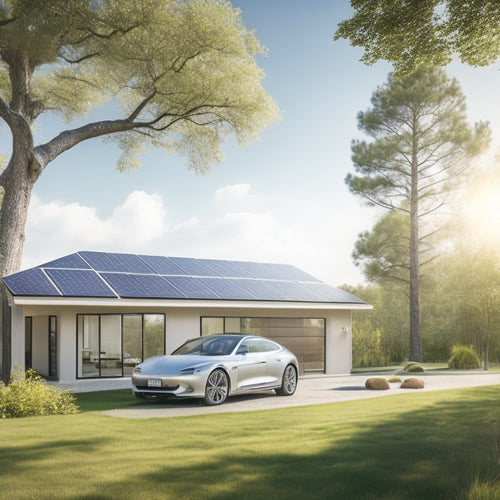
A 10-Step Checklist for Solar Panel Mounting
Share
You'll want to guarantee a successful solar panel installation by following a detailed mounting process. Start by evaluating your roof's size, condition, and orientation to determine the ideal panel capacity and energy generation potential. Next, choose the right mounting system, considering factors like roof size, structural integrity, and local regulations. Select suitable solar panels based on your energy needs and budget, and install roof anchors and clamps to secure them. Prepare the mounting structure, anchor placement, and clamp types according to manufacturer guidelines and local building codes. Secure the panels to the mount, then inspect and test the system to guarantee peak performance and safety compliance. With these vital steps covered, you're ready to take the next important steps in your solar panel installation project.
Key Takeaways
- Assess roof size, condition, and orientation to determine panel capacity and energy generation potential before installation.
- Select a suitable mounting system based on roof size, structural integrity, and local regulations to ensure a secure and efficient installation.
- Ensure the mounting system can withstand wind and snow loads, and choose systems with ideal load distribution and wind resistance features.
- Secure solar panels to the mounting structure using suitable anchors, clamps, and fasteners, following manufacturer guidelines and local building codes.
- Inspect the installed system for defects, ensuring all components function optimally, and address any issues promptly to maintain safety and performance.
Assessing Roof Size and Condition
When sizing up your rooftop for solar panels, evaluating its size and condition is essential to determine the maximum energy output and guarantee a safe installation.
You'll need to assess your roof's size to determine how many panels can fit and how much energy you can generate. Consider the roof orientation, as a south-facing roof receives the most sunlight, making it ideal for solar panels.
Conduct a shading analysis to identify any obstructions, such as trees, buildings, or skylights, that could cast shade on your panels. This analysis will help you determine the best placement for your panels to maximize energy output.
Inspect your roof's condition, looking for signs of wear, damage, or necessary repairs. Confirm your roof is structurally sound to support the weight of the solar panels and withstand environmental elements.
A thorough assessment of your roof size and condition will help you design a superior solar panel system that meets your energy needs and guarantees a safe installation.
Choosing the Right Mounting System
You're now faced with choosing the right mounting system for your solar panels, a critical step that requires careful consideration of several key factors.
You'll need to decide on the mounting type that best suits your needs, considering your roof's size and structural integrity.
Mounting Type Options
Your solar panel installation's success hinges on choosing the right mounting system, as it directly impacts the overall performance, durability, and safety of your solar array.
You'll need to take into account several factors, including installation costs, aesthetic considerations, and local regulations.
Ground mounts and pole mounts are two common options. Ground mounts are ideal for open spaces, while pole mounts are better suited for smaller areas. Adjustable racks allow for precise tilt angles, guaranteeing optimal energy harvesting. However, they may be more expensive than fixed mounts.
Wind resistance and shading issues are also significant considerations. You'll need to verify your mounting system can withstand local wind speeds and minimize shading from surrounding structures or trees.
Maintenance requirements should also be factored in, as some mounting systems may be more difficult to access or repair than others.
Roof Size Considerations
Three key roof size considerations will influence your choice of mounting system: available space, roof pitch, and obstructions. You'll need to assess these factors to determine the ideal mounting system for your solar panel installation.
Available space affects the number of solar panels you can install, while roof pitch impacts the angle at which your panels will be mounted. Obstructions, such as vents, skylights, or chimneys, may require specialized mounting equipment or affect the overall layout of your system.
| Roof Size Consideration | Impact on Mounting System |
|---|---|
| Available Space | Affects number of solar panels that can be installed |
| Roof Pitch | Impacts angle of solar panel mounting |
| Obstructions | May require specialized mounting equipment or affect system layout |
| Solar Orientation | Affects energy production and system performance |
| Shading Analysis | Identifies areas with reduced energy production |
Structural Integrity Check
Having assessed your roof's size considerations, it's now time to confirm the structural integrity of your solar panel installation.
You need to make sure that your mounting system can withstand various environmental factors, including wind and snow loads. To do this, you'll want to choose a mounting system that provides ideal load distribution. This means selecting a system that disperses the weight of your solar panels evenly across your roof, minimizing pressure on any single point.
Wind resistance is another critical factor to evaluate. You'll want to select a mounting system that's specifically designed to resist wind uplift and shear forces.
Look for systems with a low profile and a sleek design, as these tend to reduce wind resistance. Additionally, evaluate systems with built-in features like wind deflectors or aerodynamic edges, which can further reduce wind loads.
Selecting Suitable Solar Panels
You'll need to select solar panels that meet your energy requirements and fit your budget.
When choosing suitable solar panels, you should consider their efficiency ratings, as higher ratings translate to more energy production per unit area.
Additionally, you'll want to evaluate durability and lifespan, ensuring your panels can withstand environmental factors and last for years to come.
Panel Efficiency Ratings
When selecting suitable solar panels, understanding panel efficiency ratings is crucial. You want to verify you're getting the most energy output from your system. Panel efficiency ratings measure how well a solar panel converts sunlight into electricity.
- A higher efficiency rating means more energy output per hour of sunlight.
- Higher efficiency panels are more expensive, but they can be ideal for smaller rooftops or areas with limited space.
- Look for panels with efficiency ratings above 20% for peak panel performance.
When evaluating panel efficiency, consider the type of solar cells used, the temperature coefficient, and the maximum power output. These factors can impact the overall energy output of your system.
Durability and Lifespan
Selecting solar panels that can withstand the test of time is critical to guaranteeing your system's long-term performance. You want panels that can resist harsh weather conditions, such as heavy rain, strong winds, and extreme temperatures. Look for panels with a high level of weather resistance, which is typically measured by the International Electrotechnical Commission (IEC).
When evaluating the durability of solar panels, you should also consider the material longevity of the components. The frame, glass, and backsheet are critical components that affect the panel's overall lifespan. Make certain that the panels you choose have a durable frame that can withstand physical stress, and a high-quality glass or backsheet that can resist corrosion and degradation.
A durable solar panel can last for 25 years or more, providing a strong return on your investment. Be sure to check the manufacturer's warranty and performance guarantees, which can give you assurance of the panel's quality and reliability.
Preparing the Mounting Structure
The foundation of a successful solar panel installation lies in a sturdy mounting structure, which begins with a thorough preparation process.
You must verify that your mounting structure can withstand various weather conditions and support the weight of the solar panels.
To prepare the mounting structure, consider the following key factors:
-
Selecting suitable mounting materials: Choose materials that can resist corrosion, withstand extreme temperatures, and bear the weight of the solar panels and other components.
-
Assessing weather considerations: Take into account the local weather patterns, including wind speed, rain, and snowfall, to determine the structural requirements of your mounting system.
-
Conducting a site survey: Inspect the installation site to identify potential obstacles, such as vents, skylights, or roof valleys, that may affect the mounting structure's design and installation.
Installing Roof Anchors and Clamps
You're ready to move on to the next crucial step in the solar panel installation process: installing roof anchors and clamps. This step is critical to guarantee a secure and reliable connection between the solar panels and the roof.
When it comes to anchor placement, it's vital to follow the manufacturer's instructions and local building codes. Typically, anchors are placed at a minimum of 12 inches from the edge of the roof and 6 inches from any roof penetrations.
Here's a brief overview of common clamp types and their applications:
| Clamp Type | Material | Application |
|---|---|---|
| S-Clamp | Stainless Steel | For corrugated metal roofs |
| C-Clamp | Aluminum | For standing seam metal roofs |
| Universal Clamp | Stainless Steel | For asphalt shingle roofs |
Remember to choose the correct clamp type for your roof material to guarantee a secure connection. Properly install the roof anchors and clamps to prepare for the next step in the installation process.
Securing Panels to the Mount
With roof anchors and clamps securely in place, your attention turns to the essential task of securing solar panels to the mount. This step is critical to guarantee the panels remain in place, even in harsh weather conditions, and maintain peak energy production.
To secure the panels, make certain to:
-
Align the panels precisely to the mount, assuring a snug and even fit. Proper panel alignment is important for maximizing energy output and reducing stress on the system.
-
Use weather-resistant fasteners and sealants to protect the panels from the elements. This will help maintain the system's integrity and extend its lifespan.
-
Tighten all bolts and screws according to the manufacturer's specifications to prevent loosening over time. This will make sure the panels remain securely fastened to the mount, even in high-wind conditions.
Inspecting and Testing the System
Now that your solar panels are securely fastened to the mount, it's essential to inspect and test the entire system to confirm it's functioning as designed.
Start by visually inspecting the wiring connections, verifying they're securely fastened and meet electrical safety standards. Check for any signs of wear, corrosion, or damage that could compromise the system's performance or safety.
Next, test the system's electrical output using a multimeter or other testing equipment. Verify that the voltage, current, and power output match the manufacturer's specifications.
Perform a series of tests, including a ground fault test, to identify any potential electrical safety issues.
It's vital to identify and address any defects or issues at this stage to prevent safety hazards and guarantee peak system performance.
Don't assume everything is okay – take the time to inspect and test every component, from the panels to the inverter and wiring.
Frequently Asked Questions
Can I Install Solar Panels on a Metal Roof?
You're a million times closer to utilizing sunlight than you think! Yes, you can install solar panels on a metal roof, leveraging its advantages like durability and ease of installation, but consider factors like roof material, seam spacing, and structural integrity before diving in.
How Do I Handle Snow Load on Solar Panels?
When handling snow load on your solar panels, you'll want to take into account snow retention systems, which integrate with your panel design to prevent snow from sliding off and damaging the panels or surrounding structures.
Are Solar Panels Affected by Shade From Trees?
You'll maximize solar efficiency by minimizing shade impacts from trees; consider tree height when planning ideal placement, ensuring maximum sunlight exposure, and adjusting panel orientation to compensate for any shade, ensuring you utilize the most power.
Do I Need a Permit to Install Solar Panels?
You'll need to check with your local government to determine permit requirements, as installation regulations vary by region, ensuring compliance with building codes and electrical standards before you can start utilizing solar power.
Can I Install Solar Panels Myself or Do I Need a Pro?
You're considering DIY solar systems, but it's essential you assess your skill before tackling solar panel installation yourself; if you're not comfortable with electrical work, roofing, and local regulations, it's recommended to hire a professional for a safe and efficient installation.
Related Posts
-

Why Invest in Solar Car Battery Chargers Online?
By investing in a solar car battery charger online, you're not only reducing your reliance on fossil fuels but also o...
-

What Are the Average Cost Savings of Solar Panels
You can expect to save between $400 and $1,000 per year on your electricity bills with solar panels, which translates...
-

Safely Staying on Course: 5 Essential Lane Tips
You're about to take your driving skills to the next level by mastering the art of staying in your lane. First, inves...


